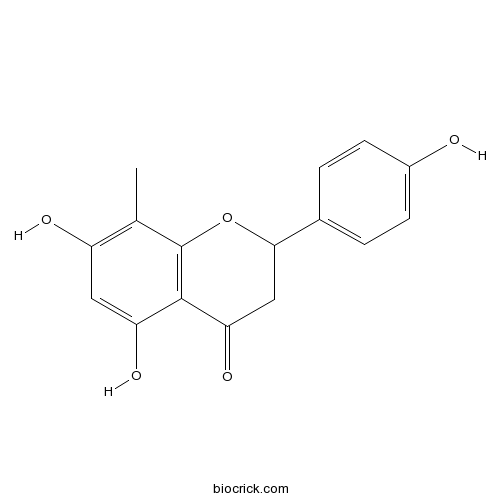5,7,4'-Trihydroxy-8-methylflavanoneCAS# 916917-28-7 |

Quality Control & MSDS
3D structure
Package In Stock
Number of papers citing our products

| Cas No. | 916917-28-7 | SDF | Download SDF |
| PubChem ID | 16094542 | Appearance | Powder |
| Formula | C16H14O5 | M.Wt | 286.08 |
| Type of Compound | Flavonoids | Storage | Desiccate at -20°C |
| Solubility | Soluble in Chloroform,Dichloromethane,Ethyl Acetate,DMSO,Acetone,etc. | ||
| Chemical Name | 5,7-dihydroxy-2-(4-hydroxyphenyl)-8-methyl-2,3-dihydrochromen-4-one | ||
| SMILES | CC1=C(C=C(C2=C1OC(CC2=O)C3=CC=C(C=C3)O)O)O | ||
| Standard InChIKey | GMVYLXBMPRDZDR-UHFFFAOYSA-N | ||
| General tips | For obtaining a higher solubility , please warm the tube at 37 ℃ and shake it in the ultrasonic bath for a while.Stock solution can be stored below -20℃ for several months. We recommend that you prepare and use the solution on the same day. However, if the test schedule requires, the stock solutions can be prepared in advance, and the stock solution must be sealed and stored below -20℃. In general, the stock solution can be kept for several months. Before use, we recommend that you leave the vial at room temperature for at least an hour before opening it. |
||
| About Packaging | 1. The packaging of the product may be reversed during transportation, cause the high purity compounds to adhere to the neck or cap of the vial.Take the vail out of its packaging and shake gently until the compounds fall to the bottom of the vial. 2. For liquid products, please centrifuge at 500xg to gather the liquid to the bottom of the vial. 3. Try to avoid loss or contamination during the experiment. |
||
| Shipping Condition | Packaging according to customer requirements(5mg, 10mg, 20mg and more). Ship via FedEx, DHL, UPS, EMS or other couriers with RT, or blue ice upon request. | ||
| In vitro | Chemical constituents from Rhododendron spiciferum and their effects on immunocyte of mice.[Reference: WebLink]Chinese Traditional & Herbal Drugs, 2010 , 41 (1) :19-23.
To study the chemical constituents from the leaves of Rhododendron spiciferum and their immunomodulatory activities. |

5,7,4'-Trihydroxy-8-methylflavanone Dilution Calculator

5,7,4'-Trihydroxy-8-methylflavanone Molarity Calculator
| 1 mg | 5 mg | 10 mg | 20 mg | 25 mg | |
| 1 mM | 3.4955 mL | 17.4776 mL | 34.9553 mL | 69.9105 mL | 87.3881 mL |
| 5 mM | 0.6991 mL | 3.4955 mL | 6.9911 mL | 13.9821 mL | 17.4776 mL |
| 10 mM | 0.3496 mL | 1.7478 mL | 3.4955 mL | 6.9911 mL | 8.7388 mL |
| 50 mM | 0.0699 mL | 0.3496 mL | 0.6991 mL | 1.3982 mL | 1.7478 mL |
| 100 mM | 0.035 mL | 0.1748 mL | 0.3496 mL | 0.6991 mL | 0.8739 mL |
| * Note: If you are in the process of experiment, it's necessary to make the dilution ratios of the samples. The dilution data above is only for reference. Normally, it's can get a better solubility within lower of Concentrations. | |||||

Calcutta University

University of Minnesota

University of Maryland School of Medicine

University of Illinois at Chicago

The Ohio State University

University of Zurich

Harvard University

Colorado State University

Auburn University

Yale University

Worcester Polytechnic Institute

Washington State University

Stanford University

University of Leipzig

Universidade da Beira Interior

The Institute of Cancer Research

Heidelberg University

University of Amsterdam

University of Auckland

TsingHua University

The University of Michigan

Miami University

DRURY University

Jilin University

Fudan University

Wuhan University

Sun Yat-sen University

Universite de Paris

Deemed University

Auckland University

The University of Tokyo

Korea University
- TC-I 15
Catalog No.:BCC6216
CAS No.:916734-43-5
- Clematiunicinoside E
Catalog No.:BCN7809
CAS No.:916649-92-8
- Clematomandshurica saponin B
Catalog No.:BCN7810
CAS No.:916649-91-7
- Coriatin
Catalog No.:BCN4457
CAS No.:91653-75-7
- Zingiberen newsaponin
Catalog No.:BCN2942
CAS No.:91653-50-8
- Senkyunolide C
Catalog No.:BCC9141
CAS No.:91652-78-7
- Clinodiside A
Catalog No.:BCN1048
CAS No.:916347-31-4
- Acetylvirolin
Catalog No.:BCN7041
CAS No.:916264-22-7
- Gopherenediol
Catalog No.:BCN6582
CAS No.:916236-79-8
- AC 55541
Catalog No.:BCC3951
CAS No.:916170-19-9
- TCS 1102
Catalog No.:BCC4063
CAS No.:916141-36-1
- Benidipine HCl
Catalog No.:BCC4395
CAS No.:91599-74-5
- Enniatin B
Catalog No.:BCN4774
CAS No.:917-13-5
- 2-[(Acetylthio)methyl]-phenylpropionic acid
Catalog No.:BCC8507
CAS No.:91702-98-6
- CYT997 (Lexibulin)
Catalog No.:BCC4601
CAS No.:917111-44-5
- Bromfenac Sodium
Catalog No.:BCC4641
CAS No.:91714-93-1
- MPC 6827 hydrochloride
Catalog No.:BCC8040
CAS No.:917369-31-4
- Letermovir
Catalog No.:BCC1700
CAS No.:917389-32-3
- Cyclo(Ile-Leu)
Catalog No.:BCN2434
CAS No.:91741-17-2
- Platycoside M1
Catalog No.:BCN3238
CAS No.:917482-67-8
- Platycoside M3
Catalog No.:BCN3243
CAS No.:917482-69-0
- PSB 0474
Catalog No.:BCC7459
CAS No.:917567-60-3
- CCMI
Catalog No.:BCC7788
CAS No.:917837-54-8
- MK-2461
Catalog No.:BCC3816
CAS No.:917879-39-1
Chemical constituents from Rhododendron spiciferum and their effects on immunocyte of mice.
Chinese Traditional & Herbal Drugs, 2010 , 41 (1) :19-23.
To study the chemical constituents from the leaves of Rhododendron spiciferum and their immunomodulatory activities. Methods The chemical constituents were isolated by various chromatography techniques and their structures were elucidated on the basis of spectroscopic data. The immunomodulatory activity of some compounds was examined by Balb/c mouse spleen lymphocyte proliferation through MTT. Results Twelve known flavonoids were isolated and identified as: quercetin-3-O-α-L-ara-binfuranside (1), quercetin-3-O-α-L-rhamnopyranoside (2), trans-taxifolin-3-O-α- arabinopyranoside (3), astilbin (4), 3-Orhamnoside engeletin (5), naringenin (6), (2S)-5,7,4'-Trihydroxy-8-methylflavanone (7), epicatechin- (2β→O→7,4β→8)-ent-epicatechin (8), proanthocyanidin A-l (9), bis-8, 8′-catechiny-lmethane (10), catechin (11), and epicatechin (12). The results showed that compounds 8, 9, and 11 alone or combined with ConA or LPS could significantly enhance the proliferation of spleen lymphocytes in a certain dose range. Conclusion This is the first report on the chemical constituents from R. spiciferum. Compounds 8,9, and 11 are found to be effect on increasing immunomodulatory activity.


